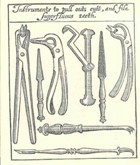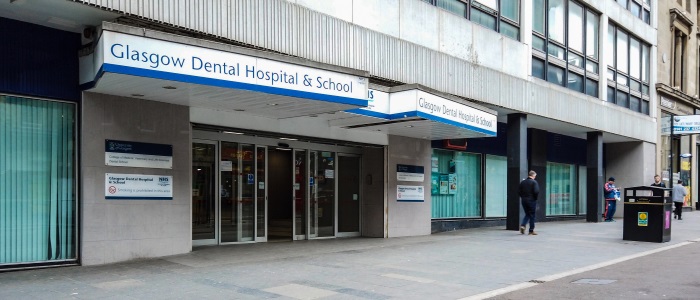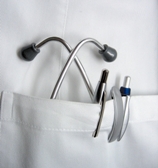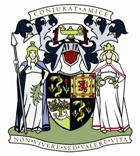History of the Dental School
Barbers and blacksmiths
 Before its foundation, tooth drawing formed an integral and recognised part of the barber 'surgeon's craft. It was also practised by blacksmiths and innumerable mountebanks who attended fairs and market places.
Before its foundation, tooth drawing formed an integral and recognised part of the barber 'surgeon's craft. It was also practised by blacksmiths and innumerable mountebanks who attended fairs and market places.
Treatment was confined to the rudimentary extraction of teeth (usually by means of the pelican or the key), the inexpert construction of bone or ivory dentures to which human teeth were often fitted and crude attempts to fill carious cavities.
The instruments tended to be devised by the operator and there was no anaesthetic to ease the pain.119
First students
The Dental school was first established in Glasgow within the Faculty of Medicine of Anderson's College following the Dentist's Act of 1878 which ensured that all entering the dental profession after August 1st, 1879 should possess a diploma, or licence to practice from one of the licensing bodies. The Faculty of Physicians and Surgeons of Glasgow (the Royal College of Physicians and Surgeons) was authorised to institute examinations in dental surgery and grant diplomas to successful candidates. The Faculty elected the first board of examiners in Dental Surgery in November 1878.120
Those who were in practice before the passing of the act were admitted for examination but others had to produce certificates of lectures and hospital practice.
Three dentists were appointed to lectureships in dentistry.
- JR Brownlie, Dental Surgery and Pathology
- J Crooks Morison, Dental Anatomy and Physiology
- WS Woodburn, Dental Mechanics and Metallurgy
About twenty students were interested in attending lectures and the first session of the Glasgow School of Dental Surgery was inaugurated on Tuesday, 3rd June 1879 by a public lecture delivered by James Rankin Brownlie. The lecturers accepted their appointments on the understanding that a Dental Hospital would also be provided. Rooms were set aside within the college buildings for the hospital. Opening in the winter session on 10th November, 1879, the Glasgow School was the first in operation in Scotland (just ahead of Edinburgh).121
Original Staff
- Mr George Buchanan
- Mr JR Brownlie LDS (Eng)
- Mr James Cummings, LDS
- Mr John Foulds, LDS
- Mr J. Crooks Morrison, LDS(Eng)
- Mr David Taylor, MB CM.
- Mr WS Woodburn, LDS
George Buchanan was a distinguished member of the dental profession and was reputed to be the first in Glasgow to use chloroform after its introduction as an anaesthetic by Simpson. Two students enrolled for two years hospital practice on the day the hospital opened. Alexander Brownlie Young and William Foulds Martin. Young gained his diploma in July 1880 and became the first house surgeon to the hospital. Martin passed in October 1880.
The Curriculum
To gain a diploma from the Faculty of Physicians and Surgeons in 1880, the student had to have spent at least four years in acquiring professional knowledge with at least three years gaining practical experience from a registered practitioner. The candidate studied
| Anatomy | one winter session |
| Anatomy (Head and Neck) | not less than 20 lectures |
| Dissection | nine months |
| Physics | a course of six months |
| Chemistry | a course of six months |
| Practical Chemistry with Metallurgy | a course of six months |
| Surgery | a course of six months |
| Medicine | a course of six months |
| Materia Medica | a course of six months |
| Attendance at recognised general hospital with clinical instruction |
not less than one year |
The final examination consisted of written papers and oral examination. The candidate might also have been tested for manipulative skill.122
Operations and treatments
During its first years when the hospital was open only in the mornings from eight until ten o'clock, six days a week, 1,266 operations were performed. There were 880 extractions, 32 of which were performed under general anaesthetic and 456 fillings.
By 1884, the numbers seeking treatment had increased, 3091 operations, 2,414 extractions and 677 fillings were performed. Many medical students also attended the Hospital to gain some dexterity in dental operations.123
First woman student (1847)
Miss Williemina Simmers was the first woman to enrol as a student in the Glasgow School. She registered on 19th March, 1897 and became the first woman to hold the Licentiate in Dental Surgery (LDS) of the Faculty of Surgeons of Glasgow.124
More than 250 years later, Dr Alyson Wray was to become the first female Vice President of the Royal College of Physicians and Surgeons.
Independent institution
Under the Educational Endowments (Scotland) Act of 1882, when Anderson's College was amalgamated with several other similar educational trusts in the new Glasgow and West of Scotland Technical College, the Medical Faculty and the Dental School had to find alternative accommodation. The Glasgow Dental Hospital and School opened as an independent institution on May 4th 1885 in new premises at George Square. The Glasgow Hospital depended on support by public subscription and student fees for hospital practice.125
The Management Committee appointed new lecturers and staff, these included WT Gairdner, MD, Professor of Medicine, Glasgow University as Consulting Physician, GHB Macleod, MD, Regius Professor of Surgery, Glasgow University, Lecturers, Dental Surgeons, Assistant Dental Surgeon and Administrators of Anaesthetics. James Rankin Brownlie was appointed Dean.126
The teaching programme was reviewed and the lecture courses were extended to two sessions. Dental Metallurgy was added to the curriculum. Local anaesthetic was thought to be used for the first time. Although financing the Hospital was difficult, the Hospital steadily developed until notice was received from the landlord that it must move as it was an inconvenience to other tenants in the building.127
At Chatham Place, equipment was restricted to the bare essentials, with simple spittoons and no sterilizers. Carbolic acid was the routine antiseptic and a rudimentary laboratory for mechanical dentistry was established The fee for two years' hospital practice was twelve guineas but a composite fee could cover hospital practice and lectures. The fees for the lecture courses were payable to the lecturers but they seemed never to be available to be paid to them and were considered a donation to the Hospital.128
By 1886, the School had by now acquired an academic reputation which attracted a steady stream of students. Income from their fees gradually brought about an improvement in the financial position of the institution. Larger premises at St Vincent Place, George Square were found.
The student served as an apprenticeship in his first month and learned what he could by observing his seniors at work. He would have been alarmed by the many crude operations, which were performed without anaesthetic.129
Dr Lunt, as a student in the second intake of the course in the 1940s, was still not allowed to give anaesthetics except in extreme situations and the patient could still be in discomfort.
"It became obvious to me when I was in final year and seeing a lot of patients that I did not really enjoy handling patients. It wasn't that I didn't like doing the actual physical work on the teeth in the patient's mouth. That I quite enjoyed doing but I was aware that I wasn't really fast enough. If I tried to go faster it simply meant that that the quality of my work deteriorated. I wasn't going to have that. But I knew that I would never satisfy the principle in Practice. And also I found it very hard work coping with patients psychologically. Because in those days we were really not allowed to give local anaesthetics except in extreme occasions and you had a frightened patient who you knew was going to be suffering pain and you were inflicting the pain. And somehow you had to cope with them, that you could get them to sit still in the chair and accept this pain as something necessary. And I found this a tremendous mental drain. At the end the day I'd be absolutely exhausted by this." 130
Student delinquency
By 1900, twenty six students were enrolled. Up until 1901, all materials required by the students for fillings had been provided free by the Hospital. However, early in 1901 the Committee of Management decided that where gold foil was to be used for a restoration the patient should buy the gold from the hospital at for one shilling and sixpence for five grains. This closed to a large extent the avenue of student delinquency, which was the collection of illicit charges from the patients. The janitor's wife was engaged to dispense materials on the authority of a surgeon and to collect the charges directly from the patient.
Progress
The Hospital moved again in May 1903 to Dalhousie Street to a suitable and reasonably equipped building out their including up to date Dentist Chairs and a small laboratory for the construction of inlays and crowns. Sir William Macewen, Consulting Surgeon was among the new staff appointed.131
Clinical teaching became more structured. In 1907, a lectureship in Dental Pathology and Bacteriology was approved by the Board and Mr J Forbes Webster was appointed. A tutor was also appointed to provide daily clinical instruction to the junior students. In 1908 an annual competition was inaugurated by the Glasgow Odontological Society for the best completed mouth by a senior student.
Many students still enrolled at the hospital just to learn the rudiments of operative techniques with no intention of completing the course or taking the diploma examination. Many were already in practice and others took only this class before commencing in practice.132
With the appointment of Mr. Adam Cubie in 1908 to the post of tutor in operative techniques, there was a major advance in the systemic teaching of the school. He was responsible for the introduction of term examinations. It was agreed that entrance to the Hospital should be restricted to students who had passed the first professional examination in chemistry, physics, anatomy and physiology. The student roll continued to increase.133
Classes at Anderson's College resumed in the winter of 1913-1914. However, during the war period, attendance of patients and students fell. Staff were also conscious that Glasgow was lacking in its own laboratory for the instruction of junior students in Dental Mechanics. Proposals were approved but deferred until the end of hostilities and in anticipation of a large influx of students.134
New regulations of the General Medical Council governing curriculum were introduced on 1st January, 1923. One of which concerned Dental Mechanics. The student had to spend at least twenty-four months or 2,000 hours being instructed at a recognised dental hospital or school. Students had previously learnt the craft in the workshop of a private practitioner. Many of the earliest graduates in dentistry had been jewellers or goldsmiths or were the sons of jewellers and were highly able in the manipulation of precious metals which were used in the construction of prosthetic and orthodontic appliances.135
In 1924, a unique appointment was made, Miss Anna Ross Galloway was appointed as assistant visiting surgeon. Some discussion took place on the propriety of appointing a lady to this office. She resigned eight months later.136
The search for a building site for the new premises continued and was found in 1926 nearby in Renfrew Street. A gargantuan programme of fund raising events was arranged. The greatest undertaking was a 'Grand Historical Pageant' to be held in Garscube Estate from 23rd to 29th June, 1928. However, in typical Scottish summer fashion, rain fell heavily and not even the presence of His Royal Highness, the Prince of Wales helped avert a disastrous financial result.137
The building fund grew slowly, the old building was sold to Glasgow School of Art for £4,000. Clinical work began in the new building on 16th November, 1931.
Renfrew Street
The top floor housed the conservation department of fifty chairs. The orthodontic department and radiological department occupied the second floor together with the main lecture room which seated over a hundred students. On the first floor was spacious accommodation for the pathological laboratory and the library and museum. The receiving rooms, operating theatre and extraction rooms were to the back of the building on the ground floor and the Dean's room, offices and staff room occupying the front, The basement housed the prosthetics laboratory and the students' accommodation.138
The new building in Renfrew Street was opened on 31st May, 1932. A public appeal was launched for the £27,000 still required for the Building Fund. In March 1935, the assistant visiting surgeons were, paid for the first time - an honorarium of £15.139
The Governors decided that a full time Dean should be appointed for five years at a salary of £1,000 per annum. The Dental Board intimated that they were prepared to offer £500 a year for five years towards the salary of a full time teacher of Clinical Dental Surgery and Director of Studies if the person appointed was of university professorial status, that a minimum salary of £1,000 per annum be paid and there should be provision for retirement at age sixty-five. The Board also stipulated that an efficient Almoner's Department be set up to ensure that dental treatment, other than necessary for the training of students should be restricted to 'necessitous persons'.140
The title of the institution reverted to 'The Glasgow Dental Hospital and School'. The Educational Grants Committee of the Dental Board had expressed the hope that the appointment of a full time Dean of university professorial status would lead to an affiliation between the School and the University.141
By the spring of 1939, the threat of war began to overshadow the country. Plans were made to maintain a three months' stock of materials in the Hospital as an emergency measure, and an arrangement was made with the Royal Dental Hospital in London to accommodate their third and fourth year students if they were evacuated.142

Affiliation with the Faculty of Medicine
By 1945, there were frequent informal meetings between the University and the Dental School to discuss affiliation. Following a formal session with the University Court in October, the Dean of the Faculty of Medicine announced that affiliation was likely to happen very soon. In 1946, the Teviot Committee recommended that the University and the Glasgow Dental School should take steps towards the inclusion of the School within the University. The Governors agreed to transfer control of the School to the University and the Principal and the Dean announced that they were satisfied with the accommodation and teaching facilities. The appointment of Dean was re-advertised as a University of Glasgow position.143
The Royal College of Physicians and Surgeons and the Dental School
The Royal College of Physicians and Surgeons and the Dental School
The Royal College of Physicians and Surgeons been responsible for conducting examinations for the LDS diploma since 1879. The Royal Colleges of England and Edinburgh instituted Fellowship diplomas in Dental Surgery in 1948 and by the 1960s the attainment of the FDS had become a necessity for further advancement in academic and hospital dentistry. However, Glasgow persisted with the Higher Dental Diploma until 1967 when the Royal College of Physicians and Surgeons of Glasgow instituted the FDS (Glasg).144
The Glasgow Dental Students Society
Formed in 1880, the Glasgow Dental Students' Society, originally, known as the Dental Students' Association of Glasgow, has been active throughout the life of the School and Hospital. The annual dinner, the Final Year Club, subscribed to over four years, inaugurated in 1880 was the culmination of the undergraduate's social life. An enjoyable meal was followed by entertainment, witty speeches and cabaret involving staff members. A souvenir magazine first produced in 1923 was a feature of the evening. Other major popular social events included the Glasgow Students' Dental Ball. and the Annual Field Day, an inter-schools contest between Glasgow, Edinburgh, Dundee and Newcastle, held since the early 1920s.145



